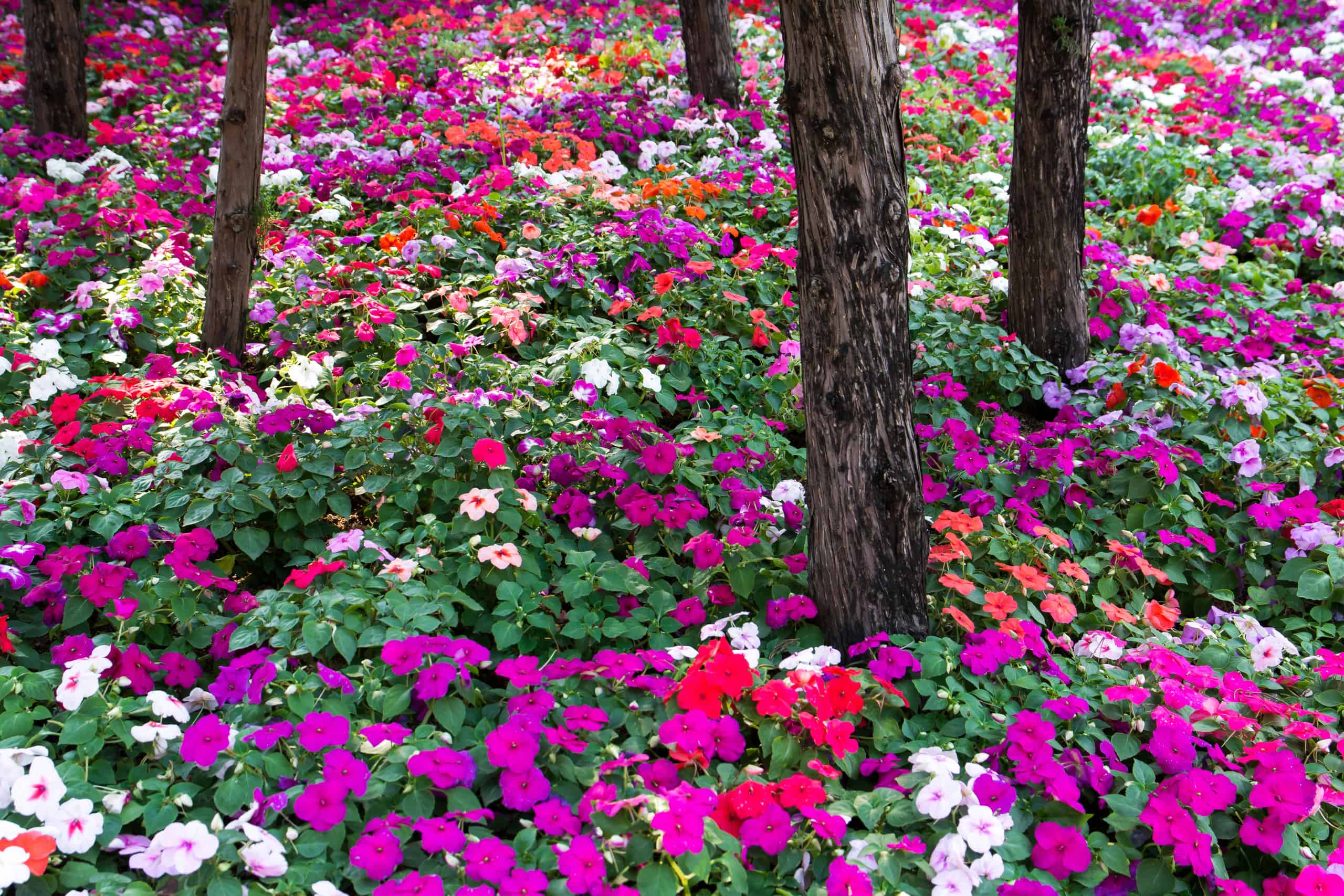Even though a great deal of flowering plants flower from spring through the beginning of summer, the garden’s flowering exhibition doesn’t end in August. In addition to the many perennial plants that will be in full bloom in the summer, many late-blooming annual blossoms in August.
Let’s take a look at some of the most stunning annuals that will add a beautiful splash of color to your garden!
1. African Marigold
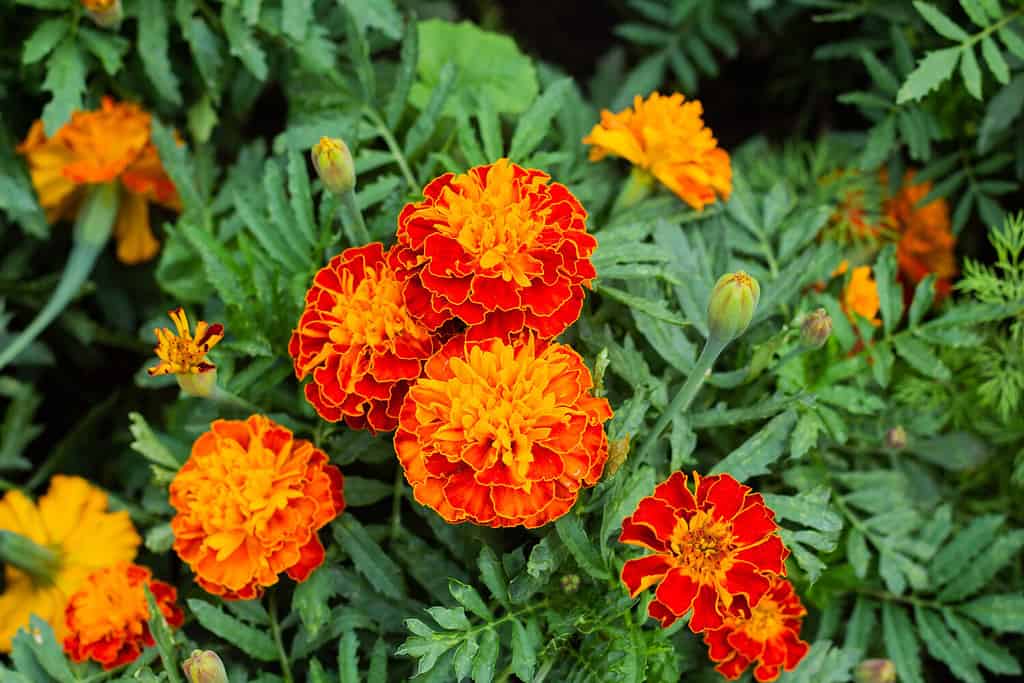
The brilliant-colored blooms of marigold have the added bonus of deterring insects.
©FunFamilyRu/Shutterstock.com
Large, colorful flowerheads in hues of off-white, orange, and yellow that develop on tall, robust stalks are characteristic of African marigolds. Flowers reach between one and four feet tall, blooming from June till frost, and both the flowers and the leaves are aromatic when touched or crushed.
We will discuss marigolds, in general, further down this list in the event that African marigolds aren’t your favorite. This breed of marigolds likes to be in soil with good drainage, average fertility, and constant moisture.
In regions with hot midday sun, sow in direct sunlight with relatively mild shading. Throw away wilted flowers right away. Plant in a location protected from high winds and torrential downpours to offer support.
African marigolds are appealing to butterflies and look beautiful in beds, hedges, pots, and edgings. They can also be used as a companion plant to create borders surrounding vegetable gardens.
2. Angelonia

Some people call this flower a “forget me not.”
©iStock.com/pimonpim
Angelonia grows best in hot, direct sunlight and comes in purple, white, pink, dusty rose, and blue hues. This plant is the perfect foundation for any garden because it grows straight and has flowering spikes.
These flowers enjoy the sun, but they also require watering when the substrate is dry, which will be nearly every day at this point in the year. If you have dead flower stalks, clip them short to encourage fresh growth.
You can grow this type of plant as a perennial if you reside in a region with barely any frost.
3. Ageratum
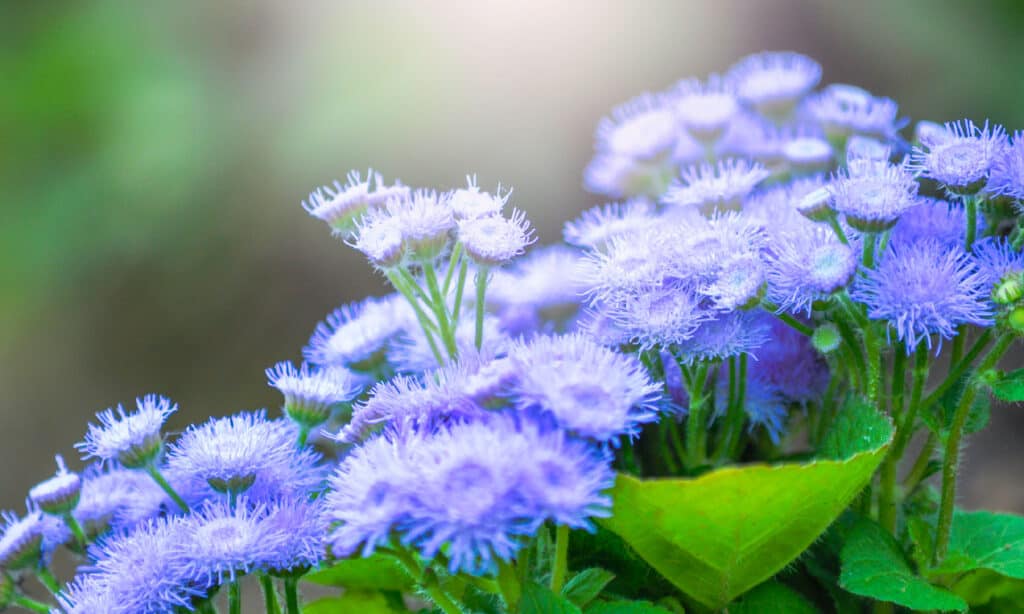
This flower gets its name from the unique spike-like petals.
©undefined undefined/Shutterstock.com
Ageratum, also known as flossflower, has cylindrical masses of aster-like, puffy flowers that are colored blue, purple, pink, and white. It flowers from May till frost, reaches between six inches and three feet tall, and has a mounding habit.
Ageratum easily cultivates on soil that drains well, has plenty of humus, and has a medium moisture content. As soon as soils become too dry, plants might wilt, thus regular watering is crucial. accepts a bit of shade and is grateful for some protection from the intense afternoon sun.
Ageratum is resistant to deer and rabbits. It attracts butterflies, and the tall forms produce excellent-cut flowers. It makes a great bedding plant and is suitable for window sills, edging, rockeries, and boundary areas.
4. Clary Sage

Eastern cultures use salvia as a medicine.
©olko1975/Shutterstock.com
Salvias, such as Clary Sage, add dependable color in the late seasons. Annual or blue clary sage, is cultivated for its exquisite bracts in shades of pink, dark blue, or white. The blossoms are inconsequential and little.
It is bright in color from June to September and is born on straight stems that extend from 18 inches to two feet high. It thrives in direct sunlight and humus-rich, well-draining soil. This plant enjoys having spent bracts removed to extend flowering and, if a few are still present, will rapidly self-seed.
Clary Sage is a great fresh-cut or dried flower and attracts butterflies and hummingbirds. It is exceptionally resistant to deer and rabbits. This flower is excellent for creating vertical interest in beds, hedges, pots, and cutting gardens particularly when planted in large groups.
5. Cleome
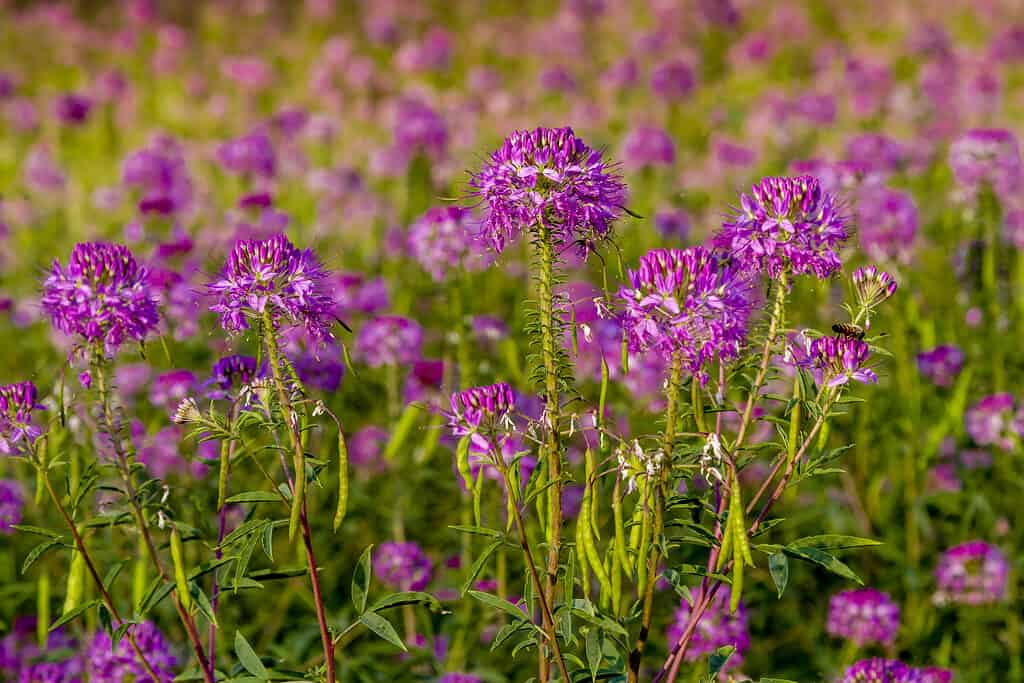
The spider flower has a musky fragrance.
©Teri Virbickis/Shutterstock.com
Spider flower, also known as cleome, has deliciously long, projecting stamens and loose, breezy flower balls in pink, violet, and white hues. From June till frost, the aromatic flowers, which are born on upright stalks and reach a height of three to six feet, bloom.
It loves full sun, low to medium humidity, and well-draining soil with typical fertility. In order to prevent self-seeding, trim ripe seedheads. Once grown, cleome is resistant to rabbits and drought. Like other late-blooming annuals on this list, you can find the spider flower attracting butterflies and hummingbirds.
In the late summer and fall, birds will stop by to pick at the seedheads. You can use cleome for vivid hues in gardens, flower beds, and other landscaping.
6. Cockscomb

Some Celosia have curled flowers that look like brains.
©iStock.com/Collinswood Images
The magnificent annual Celosia, commonly referred to as Cockscomb or Cock’s comb, appears in a variety of colors. Some of the most popular are vibrant purple, burnt orange, and pastel pink.
Additionally, there are three distinct bloom types: plumed, crested, and spiked. Consider a dwarf type of celosia if you’re concerned about them spreading all over your garden. Celosia argentea, which only reaches a height of 10 inches as opposed to the 30 inches of the conventional celosia types, is the ideal choice for smaller gardens.
Celosia plants benefit from regular hydration and full sunlight. These flowers keep their brilliant color completely intact and preserve nicely.
7. Coleus

The coleus plant is one of the most recognizable annual plants.
©EQRoy/Shutterstock.com
Delicate tropical plants called coleus are cultivated for their gorgeous, multicolored leaves. They have unlimited pattern varieties and reach heights of one to three feet. They have brilliant colors of bronze, green, copper, white, deep red, orange, light orange, red, purple, pink, and off-white.
Coleus thrive in partial to virtually complete shade and enjoy bright but indirect sunlight. Give them moderately fertile soil that drains well. It’s essential to keep the soil moist without allowing it to get soggy.
Flower stems should be pinched out for thick growth and to focus energy on the leaves. Gardeners can use this plant in shady spots to bring color to the front of borders and flower beds. Many people place these gorgeous blooms in window boxes and hanging baskets.
8. Cosmos

Despite their name, cosmos usually come in bright, warm colors.
©iStock.com/Waraphot Wapakphet
From June until the first frost, cosmos develop spectacular flowers in shades of orange, bright pink, red, white, or gold with large ray florets and yellow inner discs. Cultivars may also have two rows of petals.
Cosmos provides floating elegance to gardens and flower beds. If you’re looking for a late-blooming annual that attracts bees, butterflies, and birds, consider cosmos. They can reach heights of between one and four feet.
The stems are upright, multi-branched, and have exquisite lacy leaves. The conditions that cosmos thrives in include full sun, well-draining soil with medium fertility, and regular watering. Flowers that have finished blooming should be deadheaded, but some should be left for feeding birds, seed gathering, or self-seeding.
9. Impatiens
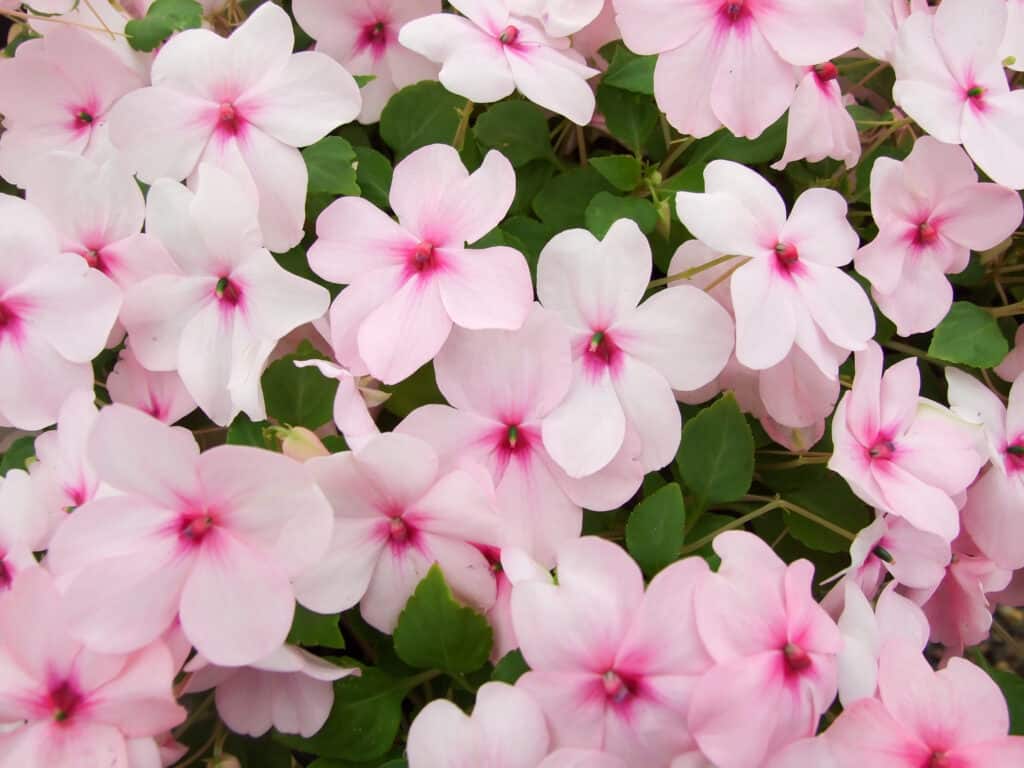
There are several hybrids of impatiens with other flowers.
©Yui Yuize/Shutterstock.com
Impatiens, one of the most popular bedding flowers in the world, is a fragile perennial that is late-blooming annual. It grows in an expanding, mounded manner from six inches to two feet tall.
Flowers blossom with five small petals that have spectacular color from June till frost. They appear in hues of mauve, bright orange, violet, pink, red, and white. Impatiens when planted in boxes, baskets, and flower beds add a subtle pop of color.
Many homeowners use them along walkways. These flowers can be cultivated successfully in soil that is evenly moist, humus-rich, well-draining, and in partial to full shade. Even in intense shade, it can bring color where other plants can’t.
10. Jasmine Tobacco

The name may lead some to believe this plant is smokable, when it is not.
©5PH/ via Getty Images
Jasmine tobacco is another delicate perennial that is a late-growing annual. It is scented at night and reaches from three to five feet tall. From June till frost, tubular flowers in shades of neon green, purple, pink, red, and white are carried on tall stalks.
This flower loves a site with full sunlight to partial shade and continuously moist, well-draining soil that is rich in organic matter. Jasmine tobacco prefers midday shade to protect from the intense heat.
11. Additional Marigolds
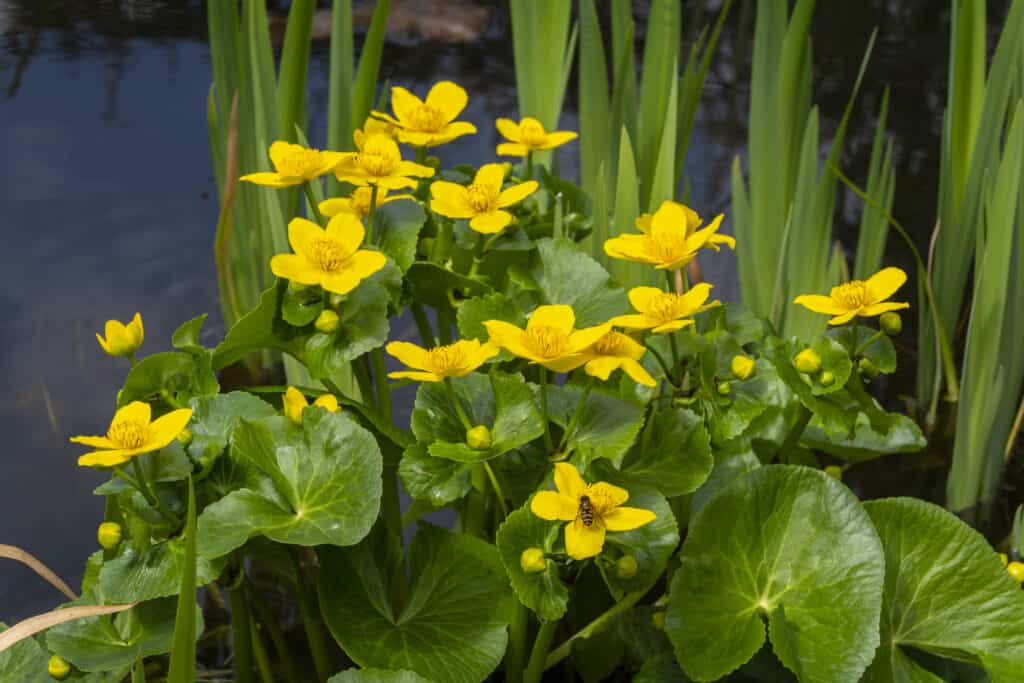
Marsh marigolds look quite different than other species of marigolds.
©iStock.com/senatorek
The odd aroma of marigolds turns off as many people as it does to allure those who like it. Regardless of your position, there is no denying that these annuals add a lot of vibrancy to garden containers.
Because of their vivid hues, marigolds are among the favorite flowers of butterflies and will continue to flower until the first deadly frost of September. These plants need to be deadheaded by removing wasted flowers to encourage fresh blooms.
They can flourish in full sun to some shade. Since many kinds only reach a height of a few inches during the growing season, marigolds make excellent annuals to utilize around the front border of a container arrangement.
12. Mealycup Sage
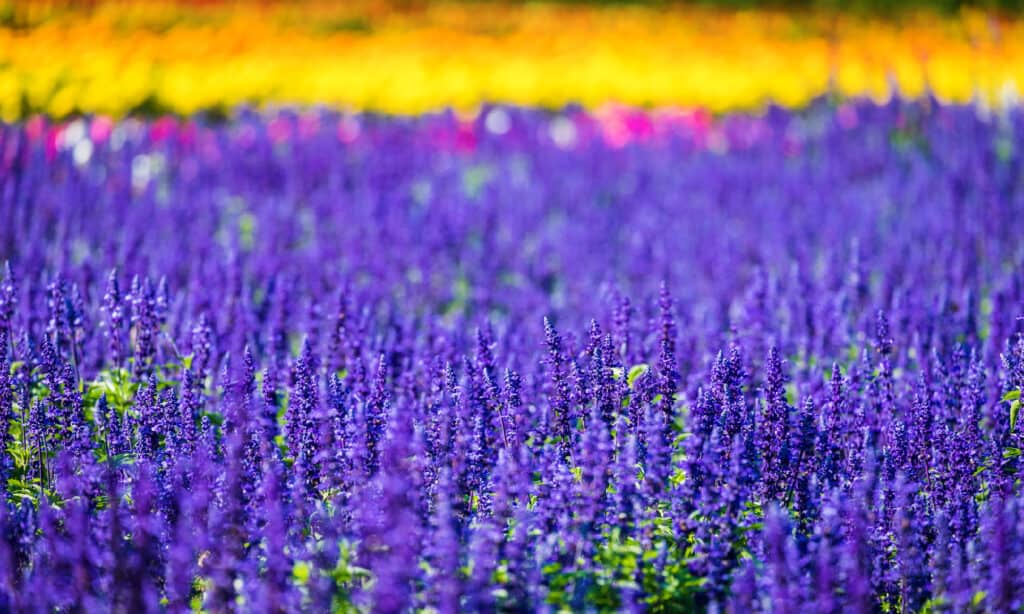
You’ll find this flower in vast fields.
©iStock.com/Biscut
The delicate, clump-forming perennial mealycup sage is frequently planted as an annual. It can reach heights of 18 inches to three feet and has broad clusters of blooms that are various hues. You can find mealycup sage in violet, white, and blue.
This flower provides continuous color to natural fields, is deer resistant, and appealing to butterflies. From May till frost, flowers bloom on upright, branching stems with glossy, green lance-shaped leaves.
It needs a site that receives full sun to partial shade, well-draining soil with moderate fertility, and consistent hydration. accepting of low soils and short-lived, but not persistent, droughts. To achieve an outstanding floral display when growing from seed, plant indoors for up to three months prior to the last date of frost.
13. Million Bells
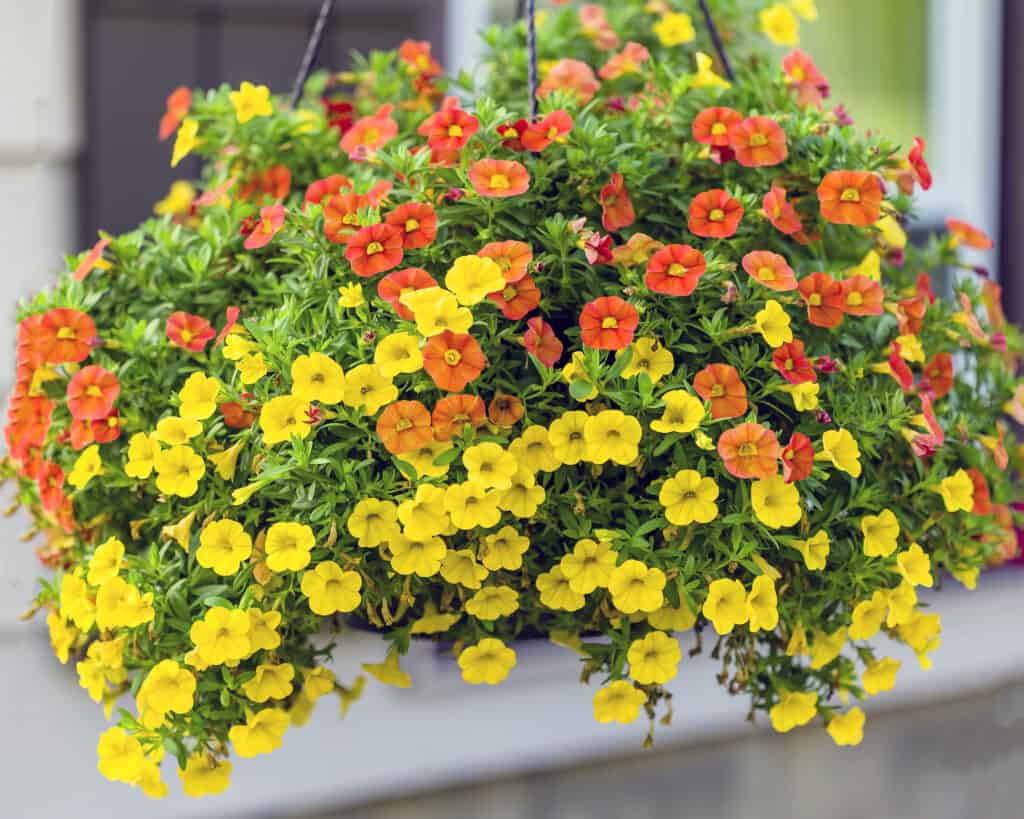
Million bell flowers look like miniature petunias.
©iStock.com/Mark R Coons
Boasting continuous heaps of tiny, petunia-like blossoms in hues of blue, copper, burgundy, mauve, pink, red, white, and yellow, million bells is a fragile perennial that can be grown as an annual.
It has a hanging style and a small, stacking growth of three to nine inches high that flowers from June until the first frost. Since this flower can withstand heat, deadheading is not necessary. It thrives in full sun, well-draining soil that has been organically enhanced, with consistent rainfall.
Million bells can withstand very little shade, but as the quantity of shade grows, fewer flowers will bloom.
14. Moss Rose
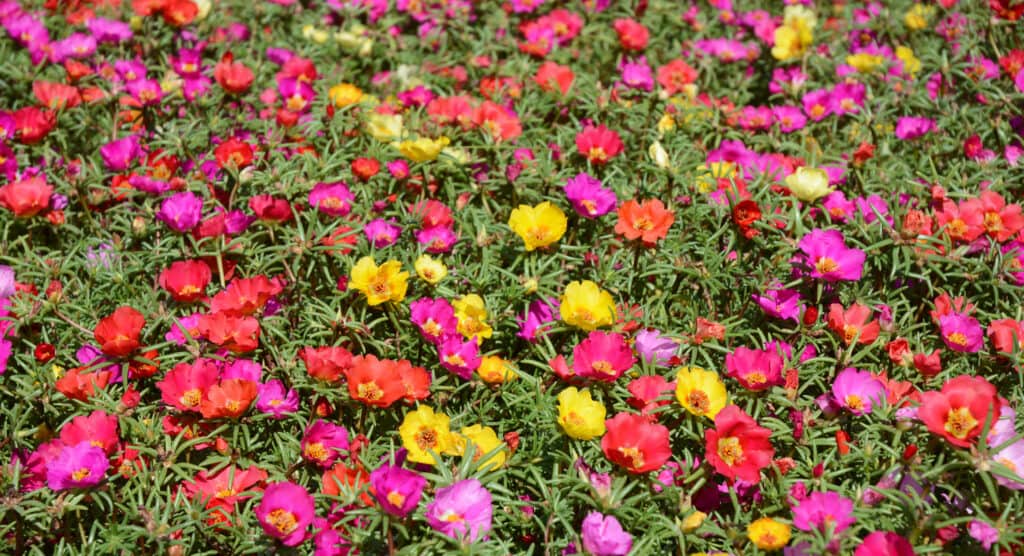
Hogweed is another name for this beautiful plant.
©iStock.com/Lex20
A low-growing annual succulent called moss rose produces bunches of ruffled, crepe-paper blossoms that flower in beautiful shades of orange, red, purple, pink, blush, white, and yellow from June till frost.
In full sunlight, well-draining soil with low to moderate moisture, moss rose can be easy to take care of. Once this flower grows, it can withstand droughts, making it a great choice for certain growing zones.
This plant can withstand drought, making it a wise choice for poor or dry soils. Commonly between six and eight inches tall, these plants have thick, needle-like leaves and flowers that shut in the evening and on overcast days.
15. Plains Coreopsis
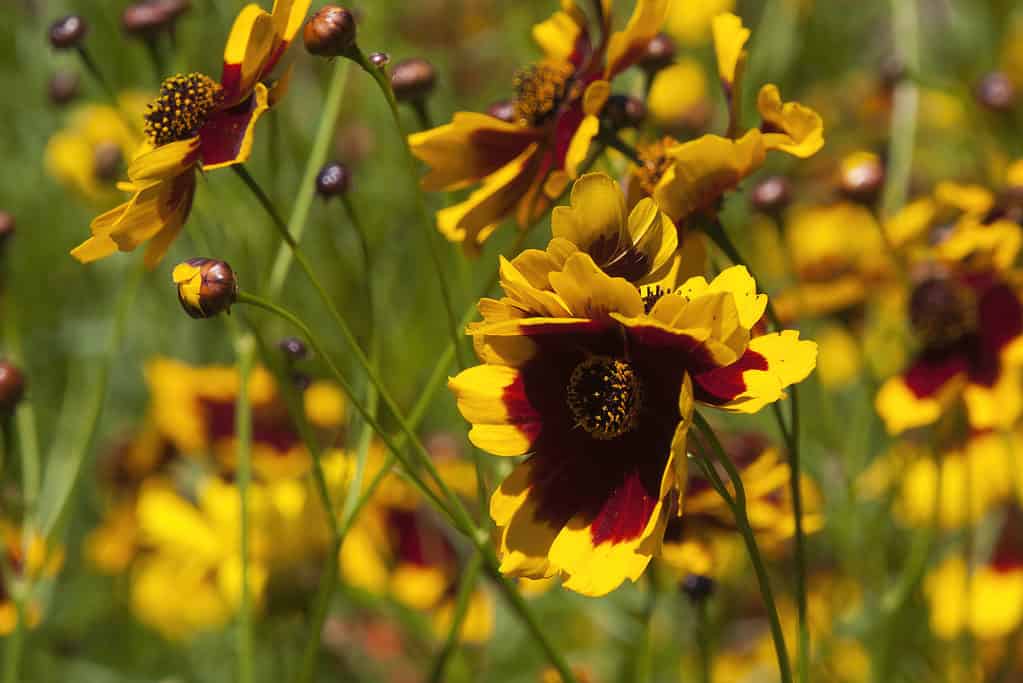
Some regions call this plant Tickseed.
©iStock.com/Karin de Mamiel
Plains coreopsis, sometimes known as calliopsis, has daisy-like blooms with dazzling yellow petals, a dark purple base, and a crimson disc center. This plant needs full to partial light, low to moderate moisture, and well-draining soil with average fertility.
It will rapidly self-seed and is adaptable to dry, rugged, or sandy substrate circumstances. It works well in locations with weak or dry soil. They have rigid, branching branches that reach a height of two to four feet, and they bloom from June to September.
16. Petunia
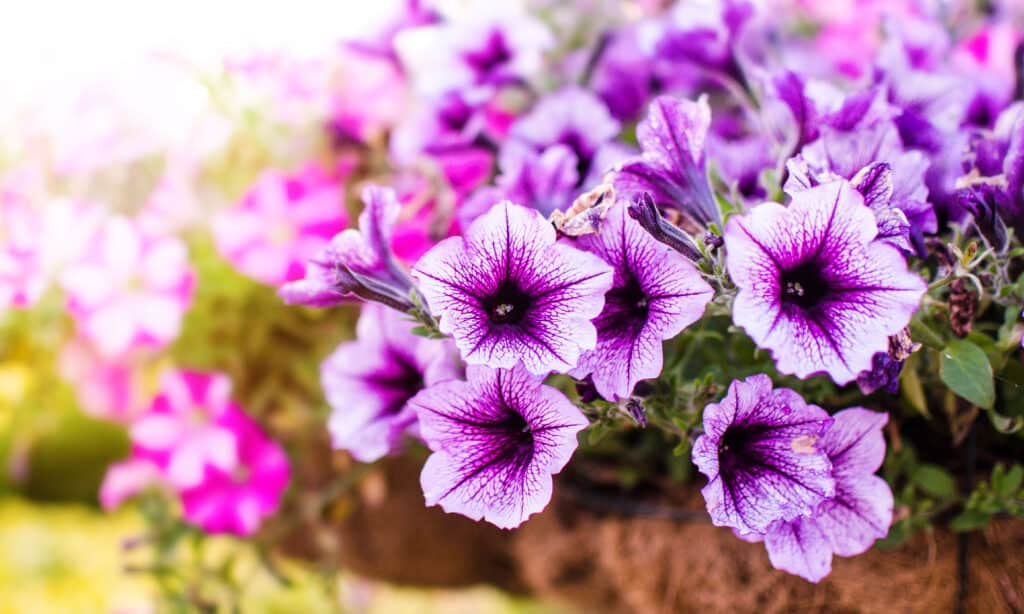
Petunias are one of the most recognizable flowers in the world.
©Maya Afzaal/Shutterstock.com
Due to their durability and wide range of colors, petunias are among the most popular annuals in the nation. Since they will very elegantly flow over the sides of fixed containers in addition to hanging baskets, they are fantastic.
If you deadhead them and give them adequate water, they’ll also offer you spectacular beauty all season long.
Up until the first frost in the fall, petunias will grow in all lighting conditions, from direct sunlight to mild shade. There are countless variations available. Have your insecticidal soap close at reach because petunias are vulnerable to insects like aphids and mites.
17. Rocktrumpet
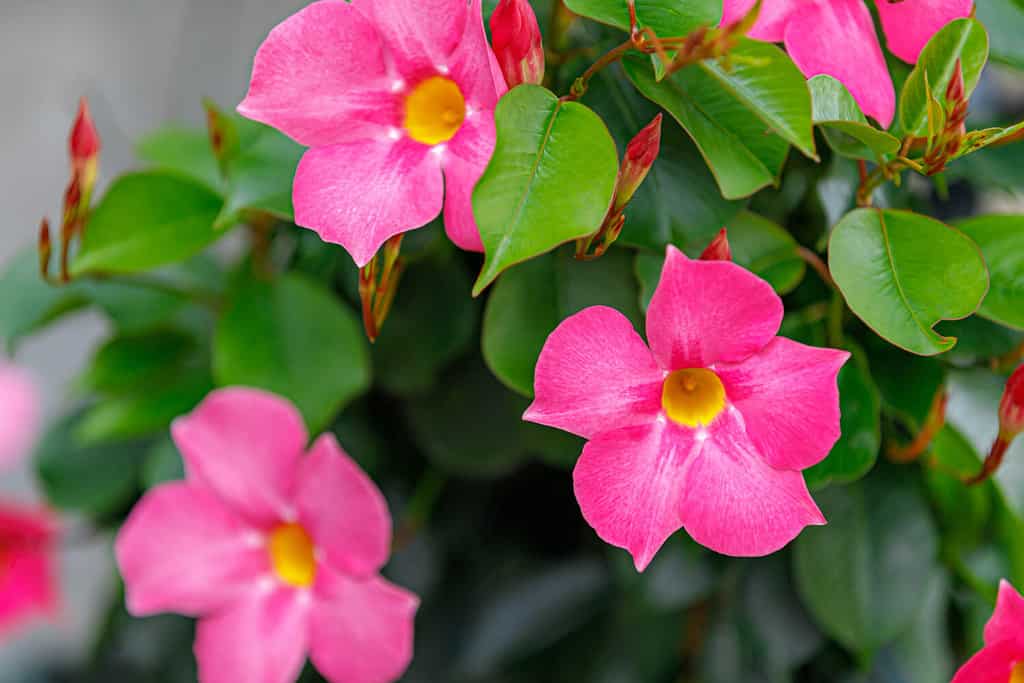
It’s ideal to plant this flower near arches or trellis’.
©Wut_Moppie/Shutterstock.com
Rocktrumpet is a quick-growing vine that can reach heights of between three and 10 feet. When this plant is placed in a container, it reaches a maximum of six feet tall. Rocktrumpet blooms from June till frost and has eye-catching trumpet-shaped flowers in pink, crimson, white, and yellow that are surrounded by dark green leaves that are shiny.
Hummingbirds are drawn to Rocktrumpet and it makes an amazing climber. Rocktrumpet, which is frost-sensitive, usually grows as an annual but can overwinter inside if planted in containers.
It favors a medium amount of moisture, well-draining, sandy soil that has been organically enhanced, and it should be given time between waterings in order for the soil to dry. Plant this late-blooming annual in a location with some shade, protection from the sweltering midday sun, and a structure for support.
18. Woolflowers
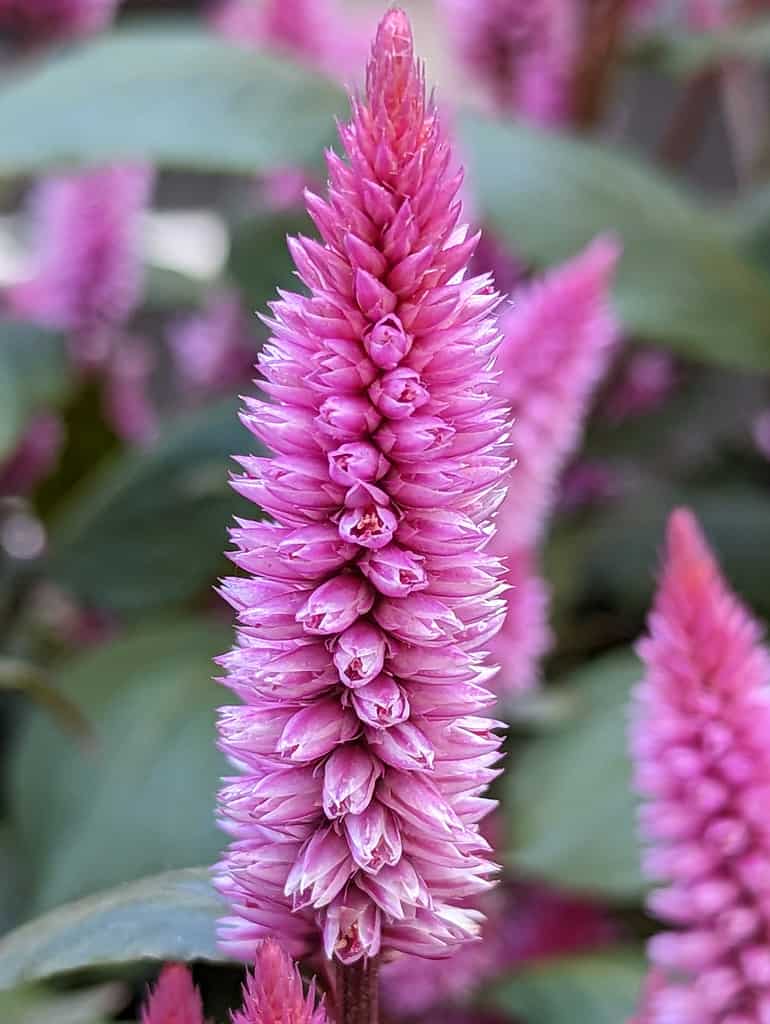
Woolflowers can add a unique look to a floral bouquet.
©Post_Insignem/ via Getty Images
From June until the first frost, woolflowers display vibrant blooms in shades of cream, orange, crimson, violet, and yellow. This traditional favorite may reach heights of six inches to three feet and has magnificent blossoms with a range of plumed, stacked, and coral shapes composed of tiny, closely packed petals.
Woolflowers are nice as fresh cut or preserved flowers and are bee and butterfly-friendly. Taller stems should be shielded from severe winds and deadheaded to extend the bloom period.
19. Zinnia

Zinnias are great companion plants for tomatoes.
©Molly Shannon/Shutterstock.com
One of the simplest flowers to plant, zinnias, blooms rapidly and provides a lot of blooms. Additionally, they will continue to bloom right up until the first autumn hard frost. Try growing zinnia flowers this year to add a huge splash of color to your yard.
To have a lot of flowers all season long, choose a place that receives full sunshine. Furthermore, later in the season, foliar diseases like powdery mildew can be avoided by planting in an area with sufficient airflow.
20. Sweet Pea Vine
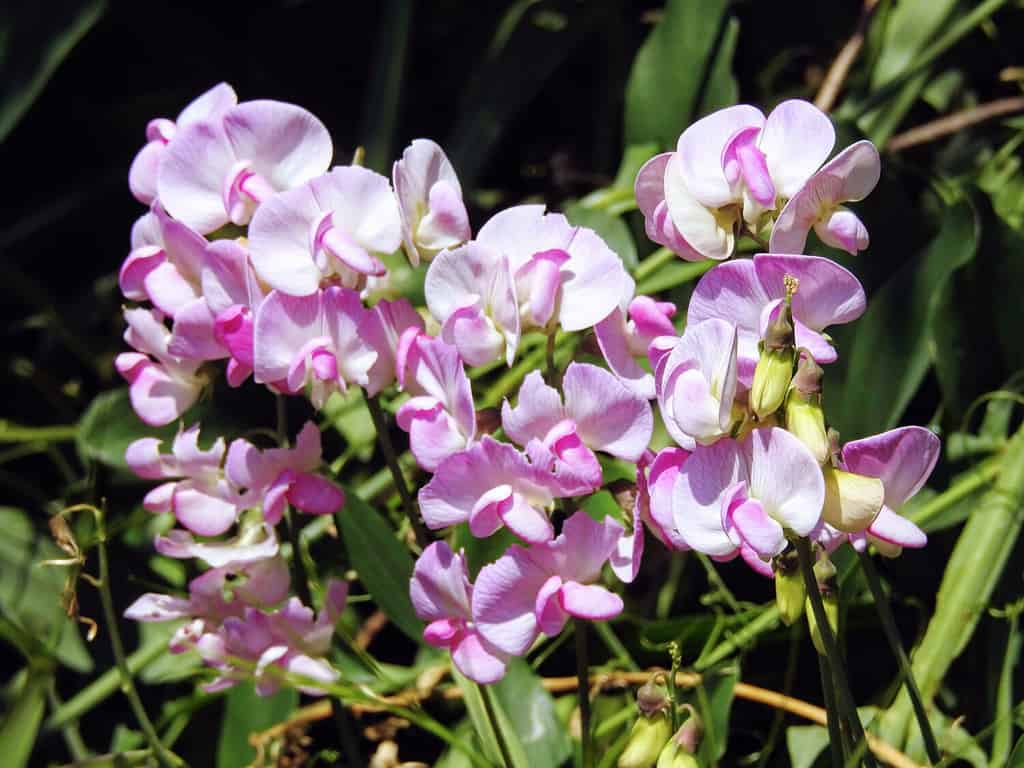
Some say this plant is “everlasting.”
©Dana.S/Shutterstock.com
The decorative sweet pea is a great plant for modest backyards because it is simple to cultivate and is beautiful and fragrant. These natural plants of the Mediterranean region prefer full sun and moist, rich, somewhat alkaline soil to develop, and they frequently benefit from blooming soil additives like bone meal or blood meal.
Most frequently, these climbing plants are observed pouring over the edges of pots or being trained up fences or walls. Even though they do best in direct sunlight, sweet peas can still thrive in areas that get a little afternoon shade in warmer regions.
Summary of the Best Late-Blooming Annual Flowers
- African Marigold
- Angelonia
- Ageratum
- Clary Sage
- Cleome
- Cockscomb
- Coleus
- Cosmos
- Impatiens
- Jasmine Tobacco
- Marigolds
- Mealycup Sage
- Million Bells
- Moss Rose
- Plains Coreopsis
- Petunia
- Rocktrumpet
- Woolflowers
- Zinnia
- Sweet Pea Vine
Thank you for reading! Have some feedback for us? Contact the AZ Animals editorial team.

